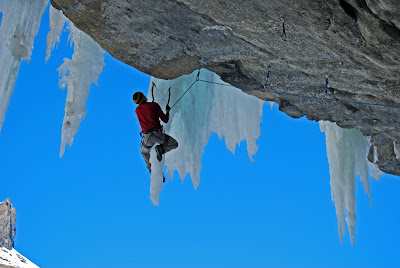 |
| Rob Gibson on the steep classice mixed line "Pink Panther" M10 |
Specific Strength and Endurance Training
1 Ice axe pull-ups
The first and most basic specific training exercise for ice/mixed climbing. Use a bar or beam and hook your axes over it. Avoid using your leashes for strength work and perform the exercises footless, with a weight belt, or even on 1-arm if you're up to it! For endurance work, keep your leashes and try using a foothold or bungee stirrup for assistance in order to perform more reps. See guidelines for number of repetitions below. Useful variations incolude pull-ups with arms at different height or travelling ice axe pull-ups where you mover from side to side at the top of each pul-up.
 |
| Pull Up bar with the fusions ready for intence training. |
2 Isometric ice axe locks
These exercises are superb for developing static strength for place pro or for locking-off whilst making your next placement. Perform them on their own or in combination with any of the above three exercises. Use three key positions: fully locked, 90 degrees and 130-150 degrees. Experiment with 1-arm work for strength and for maximum specificity, try swinging your free axe above your head 3 or 4 times as if trying to make a placement. 2-arm work, with a possible foot for assistance is best for endurance (no longer than 30 seconds). Time guidelines are given on the table below.
3 Ice/mixed bouldering
The best thing is always the real thing and if you don't happen to live near a field of iced-up leaning boulders above a snowy landing then you'll have to improvise. A convenient man-made stone wall or a specially adapted board is the next best thing. With stone walls you can work on technical hooking and torquing sequences whilst balancing your crampons on small edges. Keep your axes blunt and just use big boots without crampons if you're worried about damage. If you are using a wooden board, 5-20 degrees overhanging is the optimum angle (subject to ability) with screw-in metal 'O' rings for axe placements (available from most hardware stores) or, more crudely, pick sized drilled slots in the plyboard.You can even screw or bolt on some thick blocks of wood for simulated ice placements, or a crack section for torquing. Some bolt-on hold manufacturers offer specialist ice axe placement holds which can be worth experimenting with if you can afford to do so. But whatever happens - stay off the crags. It is also worth wearing a helmet or face guard as well as taping-up hammer, adze and spikes.
 |
| Me Training at the pleasure dome Saltdean |
4 Shoulder presses / dumbbell raises
Lifting your axes repatedly can cause a chronic shoulder pump to set in and these exercises, performed with very light weight for high reps (30-60) can help you do something about it. Both are performed seated; for the shoulder press simply raise a barbell behind your head and with the dumbells, lift them out to the side or the front with straight arms -as high as you can!
5 Tricep extensions
How fatiguing is hacking out a placement on brittle water ice? To make it all feel easier, this exercise is performed with a dumbell behind the head, one arm at a time, by simply raising the forearm and lowering it, keeping the upper arm still and vertical.
Note: for those who don't have access to weights - press-ups and parallel bar dips are ideal alternatives.
6.Wrist Curls.
The most demoralising thing of all is when your pick fires off sideways because you're too wasted to keep your wrist straight when making a placement. To combat 'jelly wrist', use a dumbbell or barbell either seated with wrists placed on the knee or kneeling with the wrists on a padded bench. Simply roll the bar up and down for as many reps as possible, experimenting with both under and an overhand grips for balanced development.
7. Leg conditioning and aerobic
The following exrcises are essential! Calf raises are performed on a step by simply going up and down on your toes until you can't take the pain any longer - no need to explain why they help. Skipping is perhaps the most specific body conditioning exercise for ice climbing, producing that familiar burm in shoulders and calves simultaneously. For those long walk-ins, needless to say running and cycling are all recommended to help you arrive in a fit state to climb.
8. 'Death sets'
Seeing as winter climbing is such a total body pump, you can combine any of the above exercises into horrendous circuit training style super-sets to produce the ultimate training affect. For example a favourite of mine is to do 10 ice axe pull-ups, 10 press-ups and then skip for a minute to recover. Do this 4 or 5 times consecutively (no cheating rests in between) and then take a full 10 minute breather before doing it again, and again, and again.....!

No comments:
Post a Comment